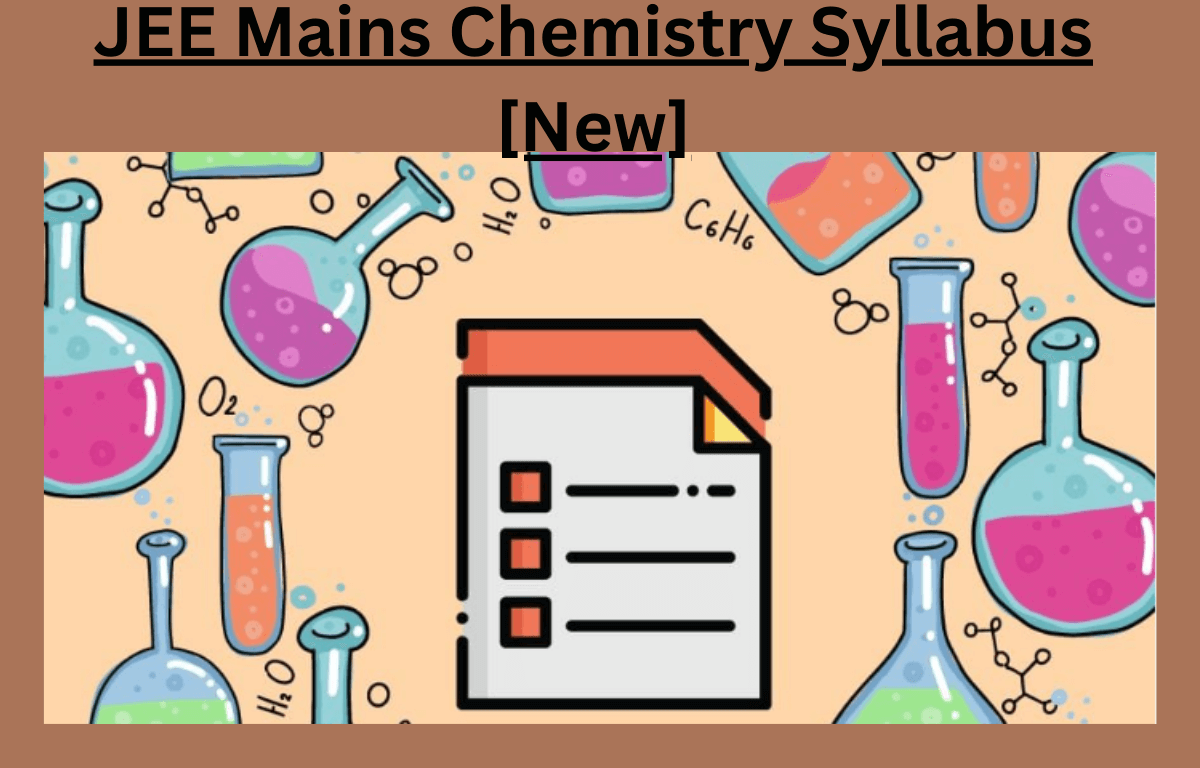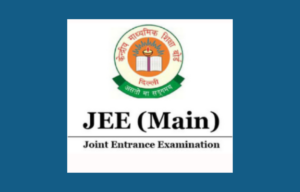JEE Mains Chemistry Syllabus 2025: The National Testing Agency has released the complete JEE Mains Syllabus 2025 on its official website i.e., www.jeemain.nta.ac.in. The students can check the JEE Mains 2025 Chemistry syllabus in online mode. The students can check the JEE Mains chemistry syllabus PDF below. Students interested in the JEE Mains 2025 are advised to thoroughly read the JEE Mains 2025 Chemistry Syllabus and must also download it. As the syllabus comprises all the important topics and the previous year’s papers will help the students to prepare well for the JEE Mains 2025 Examination.
JEE Mains 2025
The JEE Mains 2025 Examination will be conducted in two sessions: January and April. The National Testing Agency has announced the JEE Mains Exam Date 2025 for session 1 exams i.e., from January 22 to January 31, 2025. According to the latest JEE Mains Exam Pattern the Joint Entrance Examination (JEE (Main) comprises two papers: Paper 1 and Paper 2. Paper 1 (B.E./B.Tech.) is conducted for admission to Undergraduate Engineering Programs (B.E/B. Tech) at NITs, IIITs, other Centrally Funded Technical Institutions (CFTIs), Institutions/Universities funded/recognized by participating State Governments.
JEE Mains Chemistry Syllabus 2025
The topics covered in the JEE Main Syllabus 2025 for Chemistry include NCERT Class 11 and 12 Chemistry. So, the students are advised to read their NCERT Books thoroughly to cover the JEE Mains Chemistry Syllabus. As from the previous year’s analysis, JEE mains syllabus chapters from class 11th approximately have a weightage of 40% while the chapters from class 12th have a weightage of 60%. These syllabi will help the students prepare the most important topics for the JEE Mains 2024 exam.
The JEE Mains Chemistry Syllabus is divided into three sections: Section A – Physical Chemistry, Section B – Inorganic Chemistry, and Section C – Organic Chemistry. All three sections comprise a total of 28 units.
JEE Mains Physical Chemistry Syllabus: Section A
Here we have provided the JEE Mains 2025 Chemistry Syllabus which covers the topics of Physical Chemistry. It includes topics like atomic structure, chemical bonding, thermodynamics, equilibrium, solutions, electrochemistry, surface chemistry, and more. These concepts form the foundation for solving numerical problems and understanding chemical reactions, making them important for your exam preparation.
| JEE Mains Physical Chemistry Syllabus: Section A | |
| Some Basic Concepts in Chemistry | Matter and its nature, Dalton’s atomic theory; Concept of atom, molecule, element, and compound; Laws of chemical combination: Atomic and molecular masses, mole concept, molar mass, percentage composition, empirical and molecular formulae; Chemical equations and stoichiometry. |
| Atomic Structure | Thomson and Rutherford atomic models and their limitations; Nature of electromagnetic radiation, photoelectric effect; Spectrum of the hydrogen atom, Bohr model of a hydrogen atom – its postulates, derivation of the relations for the energy of the electron and radii of the different orbits, limitations of Bohr’s model; Dual nature of matter, de-Broglie’s relationship, Heisenberg uncertainty principle. Elementary ideas of quantum mechanics, quantum mechanical model of an atom, and its important features. Concept of atomic orbitals as one electron wave functions; Variation of t|/ and \|/2 with r for Is and 2s orbitals; various quantum numbers (principal, angular momentum and magnetic quantum numbers) and their significance; shapes of s, p, and d – orbitals, electron spin and spin quantum number; Rules for filling electrons in orbitals – Aufbau principle, Pauli’s exclusion principle and Hund’s rule, electronic configuration of elements, extra stability of half-filled and completely filled orbitals. |
| Chemical Bonding and Molecular Structure |
|
| Chemical Thermodynamics |
|
| Solutions | Different methods for expressing the concentration of solution – molality, molarity, mole fraction, percentage (by volume and mass both), the vapor pressure of solutions and Raoult’s Law – Ideal and non-ideal solutions, vapor pressure – composition, plots for ideal and non-ideal solutions; Colligative properties of dilute solutions – the relative lowering of vapor pressure, depression of freezing point, the elevation of boiling point and osmotic pressure; Determination of molecular mass using colligative properties; Abnormal value of molar mass, van’t Hoff factor and its significance. |
| Equilibrium |
|
| Redox Reaction and Electro-Chemistry |
|
| Chemical Kinetics | Rate of a chemical reaction, factors affecting the rate of reactions: concentration, temperature, pressure, and catalyst; elementary and complex reactions, order and molecularity of reactions, rate law, rate constant and its units, differential and integral forms of zero and first-order reactions, their characteristics and half-lives, the effect of temperature on the rate of reactions -Arrhenius theory, activation energy and its calculation, collision theory of bimolecular gaseous reactions (no derivation). |
JEE Mains Inorganic Chemistry Syllabus: Section B
The students can check the JEE Mains 2025 Chemistry Syllabus which covers the topics of Inorganic Chemistry from the table mentioned below.
| JEE Mains Inorganic Chemistry Syllabus: Section B | |
|
Classification of Elements and Periodicity in Properties |
Modem periodic law and present form of the periodic table, s, p, d, and f block elements, periodic trends in properties of elements atomic and ionic radii, ionization enthalpy, electron gain enthalpy, valence, oxidation states, and chemical reactivity. |
| p- Block Elements |
|
|
d- and f- Block Elements |
Transition Elements- General introduction, electronic configuration, occurrence and characteristics, general trends in properties of the first-row transition elements -physical properties, ionization enthalpy, oxidation states, atomic radii, color, catalytic behavior, magnetic properties, complex formation, interstitial compounds, alloy formation; Preparation, properties and uses of K2 Cr, 07 and Kmn04. Inner Transition Elements Lanthanoids – Electronic configuration, oxidation states and lanthanide contraction. Actinides – Electronic configuration and oxidation states. |
|
Co-Ordination Compounds |
Introduction to coordination compounds, Werner’s theory; ligands, coordination number, denticity, chelation; IUPAC nomenclature of mononuclear coordination compounds, isomerism; Bonding-Valence bond approach and basic ideas of Crystal field theory, color and magnetic properties; Importance of coordination compounds (in qualitative analysis, extraction of metals and in biological systems). |
JEE Mains Organic Chemistry Syllabus: Section C
The JEE Mains 2025 Chemistry Syllabus has been tabulated below, which covers almost all the topics of Organic Chemistry.
| JEE Mains Organic Chemistry Syllabus: SectionC | |
| Purification and Characterization of Organic Compounds |
|
|
Some Basic Principles of Organic Chemistry |
Tetravalency of carbon; Shapes of simple molecules -hybridization (s and p); Classification of organic compounds based on functional groups: and those containing halogens, oxygen, nitrogen and sulfur; Homologous series; Isomerism – structural and stereoisomerism. Nomenclature (Trivial and IUPAC)- Covalent bond fission – Homolytic and heterolytic: free radicals, carbocations and carbanions; stability of carbocations and free radicals, electrophiles and nucleophiles. Electronic displacement in a covalent bond – Inductive effect, electromeric effect, resonance and hyperconjugation. Common types of organic reactions- Substitution, addition, elimination and rearrangement. |
|
Hydrocarbons |
|
|
Organic Compounds Containing Halogens |
|
| Organic Compounds Containing Oxygen |
General methods of preparation, properties, reactions and uses. ALCOHOLS, PHENOLS AND ETHERS
|
|
Organic Compounds Containing Nitrogen |
|
|
Biomolecules |
General introduction and importance of biomolecules.
|
|
Principles Related to Practical Chemistry |
Detection of extra elements (N, S, halogens) in organic compounds; Detection of the following functional groups: hydroxyl (alcoholic and phenolic), carbonyl (aldehyde and ketone), carboxyl, and amino groups in organic compounds. • Chemistry involved in the preparation of the following: Inorganic compounds: Mohr’s salt, potash alum. Organic compounds: Acetanilide, p nitro acetanilide, aniline yellow, iodoform. •Chemistry involved in the titrimetric exercises -Acids bases and the use of indicators, oxalic-acid vs KMnO, Mohr’s salt vs KMnO, •Chemical principles involved in the qualitative salt analysis: Cations – Pb2+, Cu!+, Af,+, Fe1+, Zn2+, Ni2+, Ca2+, Ba2+, Mg2+, nh;. Anions- CO,”, S2~, SO4″, NO”, NO~2, Cf, Br”, I” . (Insoluble salts excluded). •Chemical principles involved in the following experiments: 1. Enthalpy of solution of CuS04 2. Enthalpy of neutralization of strong acid and strong base. 3. Preparation of lyophilic and lyophobic sols. 4. Kinetic study of the reaction of iodide ions with hydrogen peroxide at room temperature. |
JEE Mains 2025 Chemistry Deleted Topics
The National Testing Agency has updated the JEE Mains 2025 syllabus, removing some topics, especially in Chemistry, with a few changes in Maths and Physics too. Students should check the new syllabus carefully to know what’s excluded. Below is a table of the deleted Chemistry topics to help students focus on what’s important for the exam.
| JEE Mains 2025 Chemistry Deleted topics | |
| UNIT | Topics |
| Unit 1 – Some Basic Concepts in Chemistry | Physical quantities and their measurements in Chemistry |
| Precision and accuracy | |
| Significant figures | |
| S.I.Units, dimensional analysis | |
| UNIT 2: STATES OF MATTER | Classification of matter into solid, liquid, and gaseous states |
| Gaseous State: Measurable properties of gases: Gas laws – Boyle’s law, Charle’s law | |
| Graham’s law of diffusion | |
| Avogadro’s law | |
| Dalton’s law of partial pressure | |
| Concept of Absolute scale of temperature | |
| Ideal gas equation; Kinetic theory of gases (only postulates) | |
| Concept of average, root mean square, and most probable velocities | |
| Real gases, deviation from Ideal behavior, compressibility factor, and van der Waals equation. | |
| Liquid State: Properties of liquids – vapor pressure, viscosity, and surface tension, and effect of temperature on them (qualitative treatment only). | |
| Solid State: Classification of solids: molecular, ionic, covalent and metallic solids, amorphous and crystalline solids (elementary idea) | |
| Bragg’s Law and its applications: Unit cell and lattices. | |
| packing in solids (fcc, bcc, and hcp lattices), voids, calculations involving unit cell parameters, and an imperfection in solids. | |
| Electrical and magnetic properties. | |
| Unit 3 – Atomic Structure | Thomson and Rutherford’s atomic models and their limitations |
| Unit 10: Surface Chemistry | Adsorption- Physisorption and chemisorption and their characteristics, factors affecting adsorption of gases on solids |
| Freundlich and Langmuir adsorption isotherms, adsorption from solutions. | |
| Catalysis – Homogeneous and heterogeneous, activity and selectivity of solid catalysts, enzyme catalysis, and its mechanism. | |
| Colloidal state- distinction among true solutions, colloids, and suspensions, | |
| classification of colloids – lyophilic. lyophobic; multi-molecular. macromolecular and associated colloids (micelles) | |
| Preparation and properties of colloids – Tyndall effect | |
| Brownian movement, electrophoresis, dialysis, coagulation, and flocculation: | |
| Emulsions and their characteristics. | |
| Unit 12 : General Principles And Processes Of Isolation Of Metals | Modes of occurrence of elements in nature, minerals, ores |
| Steps involved in the extraction of metals – concentration, reduction (chemical and electrolytic methods), and refining with special reference to the extraction of Al. | |
| Cu, Zn, and Fe; Thermodynamic and electrochemical principles involved in the extraction of metals. | |
| Unit 13: Hydrogen | Position of hydrogen in the periodic table, |
| Isotopes, preparation, properties, and uses of hydrogen | |
| Physical and chemical properties of water and heavy water | |
| Structure, preparation, reactions, and uses of hydrogen peroxide | |
| Classification of hydrides – ionic, covalent, and interstitial. Hydrogen as a fuel. | |
| Unit 14: S -Block Elements | General introduction |
| Unit 15 – p-Block Elements | Electronic configuration, and general trends in physical and chemical properties of elements. |
| Anomalous properties of the first element of each group, diagonal relationships. Preparation and properties of some important compounds – sodium carbonate and sodium hydroxide and sodium hydrogen carbonate; | |
| Industrial uses of lime, and limestone. Plaster of Paris and cement: Biological significance of Na, K. Mg, and Ca. | |
| Groupwise study of the p-block elements Group -13: Preparation, properties, and uses of boron and aluminum
Structure, properties, and uses of borax, boric acid, diborane, boron trifluoride, aluminum chloride, and alums. |
|
| Group -14, The tendency for catenation; Structure, properties, and uses of Allotropes and oxides of carbon, silicon tetrachloride, silicates, zeolites, and silicones. | |
| Group -15, Properties and uses of nitrogen and phosphorus; Allotropic forms of phosphorus; Preparation, properties, structure, and uses of ammonia, nitric acid, phosphine, and phosphorus halides. | |
| Group -16: Preparation, properties, structures, and uses of ozone: Allotropic forms of sulfur; Preparation, properties, structures, and uses of sulphuric acid | |
| Group-17: Preparation, properties, and uses of hydrochloric acid; Trends in the acidic nature of hydrogen halides; Structures of Interhalogen compounds and oxides and oxoacids of halogens. | |
| Group-18: Occurrence and uses of noble gases; Structures of fluorides and oxides of xenon. | |
| Unit 18: Environmental Chemistry | Environmental pollution – Atmospheric, water, and soil. |
| Atmospheric pollution – Tropospheric and Stratospheric Tropospheric pollutants – Gaseous pollutants: Oxides of carbon, nitrogen, and sulfur | |
| Hydrocarbons their sources, harmful effects, and prevention; Greenhouse effect and Global warming | |
| Acid rain; Particulate pollutants: Smoke, dust, smog, fumes, mist; their sources, harmful effects, and prevention. | |
| Stratospheric pollution- Formation and breakdown of ozone, depletion of the ozone layer – its mechanism and effects. | |
| Water Pollution – Major pollutants such as. pathogens, organic wastes, and chemical pollutants; their harmful effects and prevention. | |
| Soil pollution – Major pollutants such as; Pesticides (insecticides. herbicides and fungicides), their harmful effects, and prevention. | |
| Strategies to control environmental pollution | |
| Unit 25: Polymers | General introduction and classification of polymers |
| General methods of polymerization, – Addition and condensation. | |
| Copolymerization. Natural and synthetic, rubber and vulcanization, | |
| Some important polymers with emphasis on their monomers and uses – polythene, nylon, polyester, and bakelite | |
| Unit 27: Chemistry In Everyday Life | Chemicals in Medicines – Analgesics, tranquilizers, antiseptics, disinfectants, antimicrobials, anti-fertility drugs, antibiotics, antacids. Anti-histamines. |
| Chemicals in food – Preservatives, artificial sweetening agents – common examples. Cleansing Agents – Soaps and detergents, cleansing action | |
Most Important Topics of Chemistry For JEE Mains 2025
Knowing the key Chemistry topics for JEE Mains 2025 is essential for better preparation. It helps students focus on important areas, use their time wisely, and improve their chances of scoring well in the exam. By studying these topics thoroughly, students can prepare more effectively and avoid wasting time on less important material. Below is a list of some of the most important Chemistry topics for JEE Mains to help you plan your studies efficiently.
- Atomic Structure
- Chemical Kinetics
- Organic Compounds Containing Oxygen
- Equilibrium
- Transition Elements (d and f Block)
- Chemical Bonding and Molecular Structure
- Some Basic Principles of Organic Chemistry
- Coordinate Compounds
- Chemical Thermodynamics.
Best Books for JEE Mains Chemistry Preparation
To prepare for JEE Main Chemistry, having the right books is important. These books help you understand the concepts better and practice questions. A good book will explain things in a simple way and give you many practice problems to solve. Some of the best books for JEE Main Chemistry are listed below. These books cover all topics and are useful for both beginners and advanced students. These books will guide you to do well in the Chemistry section of JEE Main.
- NCERT Chemistry (Class 11 and 12)
- Modern Approach to Chemical Calculations by R.C. Mukherjee
- Organic Chemistry by O.P. Tandon
- Physical Chemistry by P. Bahadur
- Inorganic Chemistry by J.D. Lee
- Arihant’s Practice Book for JEE Chemistry



 JEE Main 2026 Registration (Session 1)...
JEE Main 2026 Registration (Session 1)...
 JEE Main Cut Off 2025 Out: Check General...
JEE Main Cut Off 2025 Out: Check General...
 JEE Main Final Answer Key 2025 - NTA Res...
JEE Main Final Answer Key 2025 - NTA Res...













